As an Amazon Associate, I earn from qualifying purchases.
Learn the secrets to Removing Rust From Cast Iron without toxic chemicals or harsh treatments. You’ll also learn how to clean and season cast iron, and LOVE your skillets and dutch ovens.
There are a few tools that every cook should have in their kitchen – a great set of knives, a heavy-duty stand mixer, a food processor, stainless steel nesting mixing bowls, a dutch oven, and a cast iron skillet.
Cast iron is one of those things that people either LOVE, or it scares the beejesus out of them because they don’t understand it. The common complaints people have against cast iron:
1) “it rusts”
2) “they’re heavy”
3) “I don’t know how to use it and food always sticks.”
Today, I’m here to convince you that cast iron rules and belongs in your kitchen!
Benefits of Cast Iron
- Cast iron cookware is durable. It’s not uncommon to find people using the pans they inherited from their granny.
- Many are made in the USA (Lodge brand)
- It distributes heat evenly. And you can (and should) cook on lower heat using cast iron. Lower heat = lower energy bills.
- It can help add iron to your diet.
- It cooks food beautifully. Roasted veggies and cornbread are 100% better when cooked in cast iron than something else. FACT.
- It can go from stovetop to oven, to a campfire if necessary.
- Once properly seasoned, you don’t REALLY have to wash cast iron.
Removing Rust From Cast Iron
If you’ve ever passed over a rusty skillet at a thrift shop or garage sale, STOP! Those pans are not beyond repair and with a little elbow grease, they can become a family heirloom.
Step One:
Clean the skillet with soap and water. In my humble opinion, this is one of the last times your skillet should need soap.
Step Two:
Give it a 10-minute steam bath in a 350-degree oven.
Step Three:
Using a rag you don’t mind getting dirty, paper towels, or pieces of newspaper, work the oil and salt into all parts of the skillet. Pay special attention to the rusty areas.
Pro tip: you can also use a potato cut in half to scrub the salt into the skillet. Potatoes contain oxalic acid which is a natural rust remover. Steel wool can also be used for removing rust from cast iron.
Light rust is called profile rusting. If you have a more stubborn rust situation, we’ll talk about that below.
Step Four:
Carefully wipe out the extra oil from the skillet using paper towels. Using another paper towel, work any remaining oil around to cover the entire surface of the skillet. Lightly oil the outside and the handle.
Make sure to remove all excess oil from the pan. There should be no puddling or obvious pooling of oil. Pro tip: if you leave too much oil on the pan, during the seasoning process in step five your pan will likely develop a sticky residue.
Step Five:
Flip the pan upside down and place it on the top rack of your oven. Bake for 90 minutes at 350 degrees. Some people may recommend putting down a piece of foil or a baking sheet on the rack under the skillet while it bakes.
If you removed all the extra oil like advised, this isn’t necessary. But if it gives you peace of mind to keep your oven extra clean then totally do it.
Pro tip: this will create some smoke in your kitchen. Make sure to turn on your vent hood and maybe crack a window to help. My husband has asthma and the odor does bother him so I will only season cast iron when he is out of the house.
Allow it to cool in the oven and then repeat step four and five until the surface is non-stick (1-4 total cycles depending on the state of the skillet when you started).
After round one in the oven:
After round two in the oven:
What is the best oil to season a cast iron skillet?
You’ll need a high heat oil for seasoning cast iron. A few of the oils that are considered safe at temps over 300 degrees F are:
- Almond
- Avocado
- Canola
- Coconut
- Grapeseed
- Safflower
- Sunflower
- Vegetable
Depending on your dietary needs (specifically, AIP, paleo, and Whole30), some of these oils may not be considered a good choice.
How to Remove Excessive Rust From Cast Iron
Option 1: If the rust is REALLY stubborn, put the skillet in the oven on the self-clean cycle. This will strip everything from the pan and give you a blank slate to reseason.
Then wash with hot soapy water and follow steps four and five.
Option 2: You can also submerge it in a sink with 50% water and 50% white vinegar. Soak for 1-8 hours. Then wash with hot soapy water and follow steps four and five.
Option 3: Fill the skillet with regular Coke and let it sit overnight. Then wash with hot soapy water and follow steps four and five.
How to Cook In Cast Iron
Cast iron can be used for most dishes, but acidic foods such as vinegar and tomatoes should be avoided as they can eat away at your careful seasoning.
Never put food in a cold cast iron skillet. You’ll always want to preheat your cast iron over medium-low heat for a few minutes.
Before adding food you’ll need to brush some sort of fat (oil, butter, bacon grease, etc.,) on the cooking surface to help keep the pan non-stick.
One of the amazing benefits of cast iron is that you can start it on a burner and then pop it in the oven. We use that method for our Whole30 + Paleo Frittata. Cast iron is the ultimate tool for one-pan meals.
Cleaning a Cast Iron Pan After Use
After your delicious meal of Blistered Shishito Peppers, you can simply let the pan cool a bit and then wipe out any leftover oil with a paper towel. That’s right – no need to scrub, rinse or wash the skillet with soap and water.
You worked really hard to season your skillet. Soap will remove the careful seasoning and is not necessary. Never soak your cast iron or god forbid put it in the dishwasher!
I don’t think I have to explain to you how amazing it is to have one less dish to wash! Imagine whipping up a batch of Whole30 Skillet Fried Potatoes for brunch knowing that you don’t have to wash that dish.
Occasionally, the cooking process will leave some stuck on food that can’t be removed by gentle wiping. In that case, rinse the skillet under water and gently scrub it with a soap-free brush.
Lodge even makes a handy little chainmail wire scrubber specifically made for cleaning cast iron.
If you have to clean cast iron with water you’ll want to thoroughly dry your skillet and then quickly reseason it. This can be as simple as wiping a bit of oil into the pan and putting it on a warm burner for 10 minutes.
If your oven is still warm/hot from cooking, pop it in there after adding some oil and let it sit until the oven has cooled.
Routine Cast Iron Skillet Care
If you notice that your skillet is becoming less non-stick, follow steps 4 and 5 above to create an extra layer of seasoning on the cooking surface.
To save time and money, this is best done right after you’ve used the oven for cooking a meal. Or even while you’re using your oven for something else like baking bacon in the oven.
Example: you just made a batch Simple Shepherds Pie With Turkey. Once the food has been dished up, wipe the skillet out with a paper towel or clean kitchen rag. Apply a small amount of high heat oil to the skillet and buff it into the cooking surface with a clean paper towel.
Pop the skillet back into the still-warm oven and keep it there until it fully cooled. Routine cast iron skillet care and upkeep like this will keep your skillet in prime fighting shape. Or, you know, cooking shape.
Cast Iron Rust Prevention
Cast iron can be prone to rusting if stored improperly or put away before it is fully dried. Certain climates (coastal conditions and humidity) may require you to repeat steps 1-5 occasionally if profile rusting develops.
Storage: if you stack skillets in your cupboard, place a paper towel or piece of newspaper between each skillet. This prevents chipping and rust spots developing from skillet to skillet contact.
When To Throw Out Cast Iron
As durable as cast iron is, there are some pieces of cookware so mistreated that they are beyond repair and unsafe to use. Your cast iron should be tossed if there is deep pitting on the cooking surface, or there are cracks or chips in the pan.
Cast Iron Skillet Recipes
Now that you have a gorgeous seasoned skillet, let’s get cooking!
- Cast Iron Pizza
- Baked Cauliflower Patties
- Jalapeno Poppers Dip
- Crispy Oven-Roasted Butternut Squash
- Paleo Salmon Cakes
- Whole30 Quiche
- Whole30 Breakfast Sausage
- Fried Cabbage With Bacon
Removing Rust From Cast Iron {How to Season Cast Iron}

Ingredients
- 1 cast iron skillet
- 1 high heat oil
- 1 kosher salt
- paper towels or newspapers
Instructions
- Clean the skillet with soap and water.
- Give it a 10-minute steam bath in a 350-degree oven.
- When it is dry, carefully remove the pan from the oven and pour a puddle of high-heat oil (see list below) and a generous helping of kosher salt into the center.
- Using a rag you don't mind getting dirty, paper towels, or pieces of newspaper, work the oil and salt into all parts of the skillet. Pay special attention to the rusty areas.
- Rinse the salt out of the skillet. Put it on the stovetop on medium heat with a small amount of high-heat oil, and work it around with another rag. I use a pastry brush. Let it heat and "cure" for about 5 minutes.
- Carefully wipe out the extra oil from the skillet using paper towels. Using another paper towel, work any remaining oil around to cover the entire surface of the skillet. Lightly oil the outside and the handle.
- Make sure to remove all excess oil from the pan. There should be no puddling or obvious pooling of oil. Pro tip: if you leave too much oil on the pan, during the seasoning process in step five your pan will likely develop a sticky residue.
- Flip the pan upside down and place it on the top rack of your oven. Bake for 90 minutes at 350 degrees. Some people may recommend putting down a piece of foil or a baking sheet on the rack under the skillet while it bakes.
- If you removed all the extra oil like advised, this isn't necessary. But if it gives you peace of mind to keep your oven extra clean then totally do it. Pro tip: this will create some smoke in your kitchen. Make sure to turn on your vent hood and maybe crack a window to help.
- Allow it to cool in the oven and then repeat step four and five until the surface is non-stick (1-4 total cycles depending on the state of the skillet when you started).
Notes

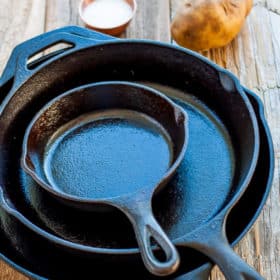
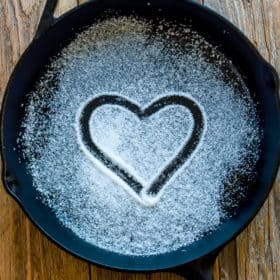
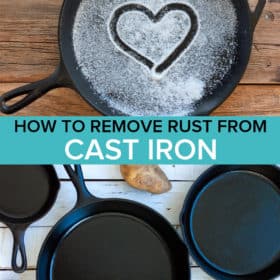
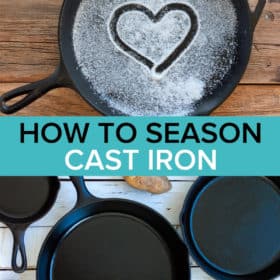
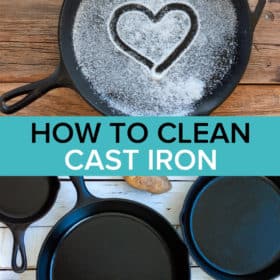
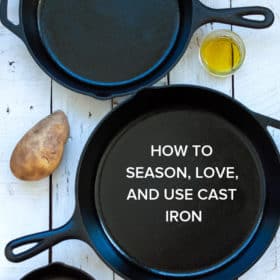
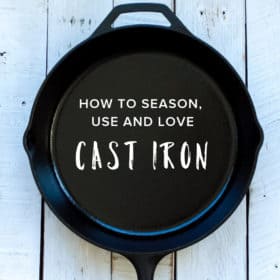

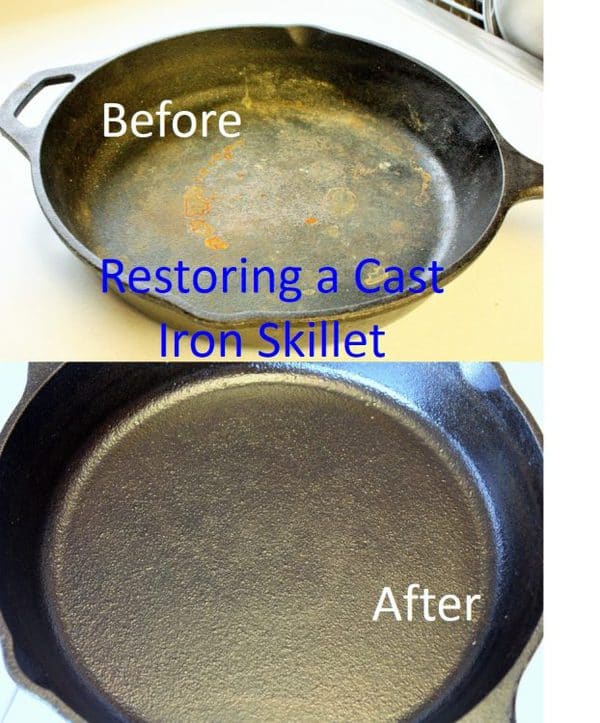
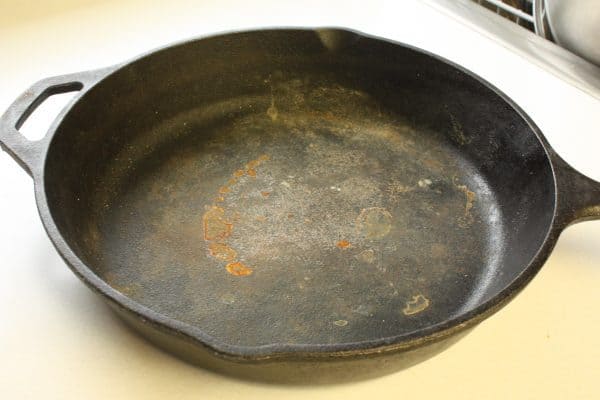
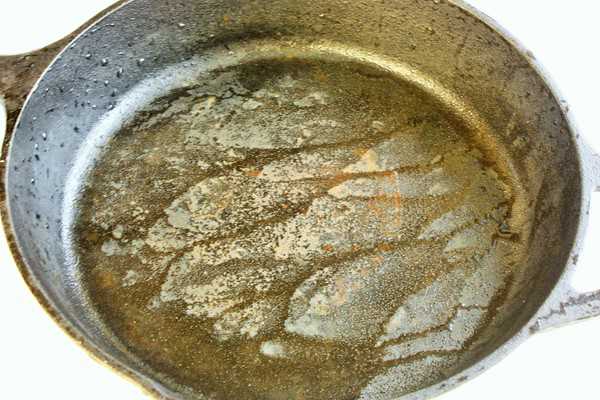
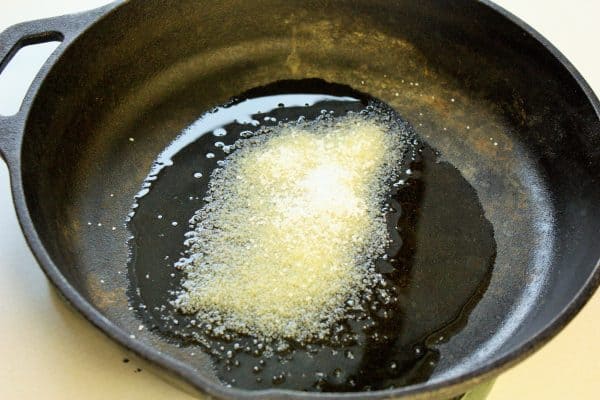
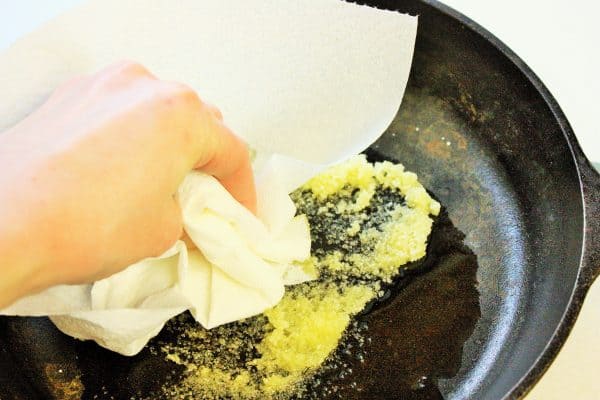
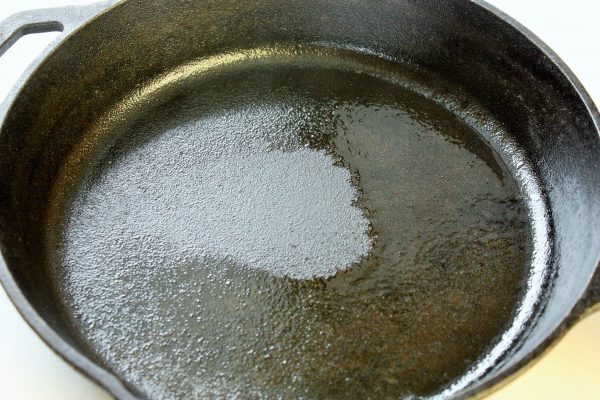
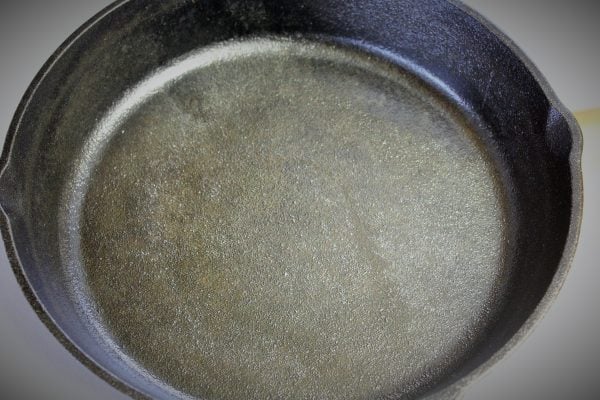
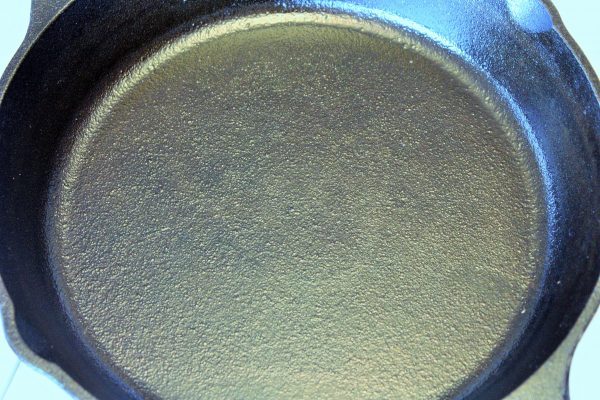
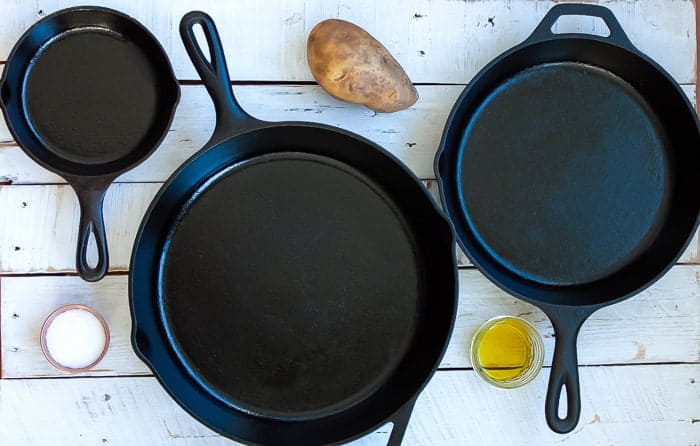
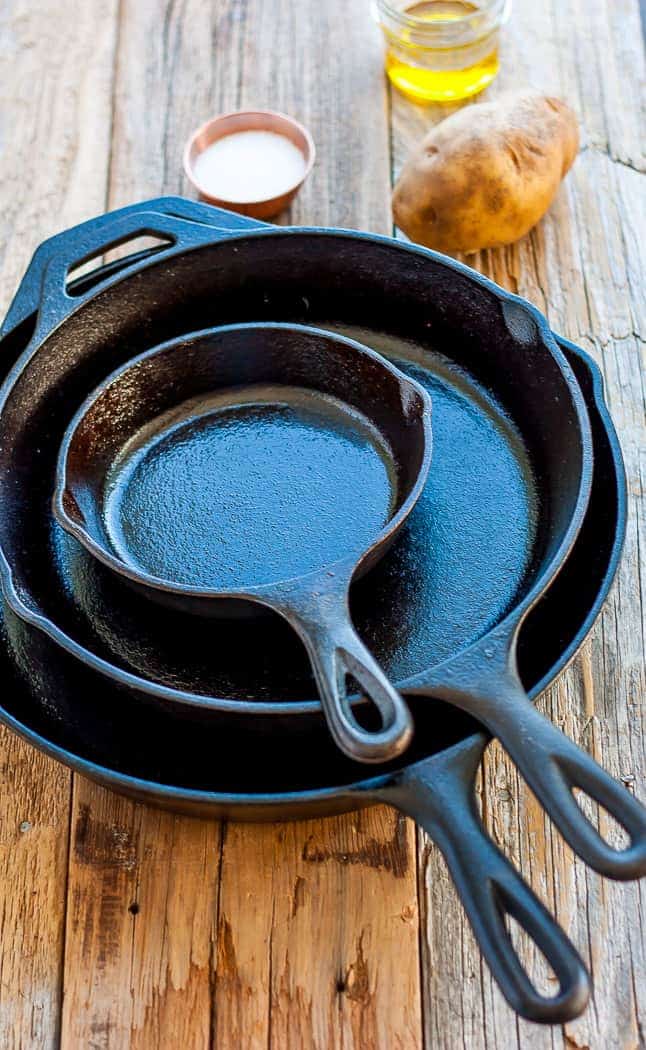
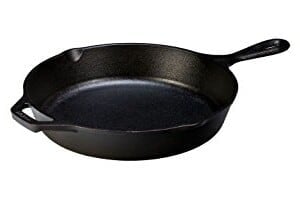
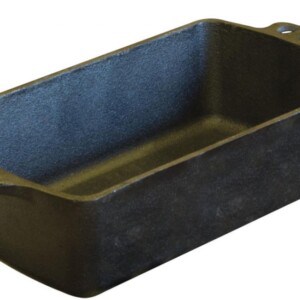
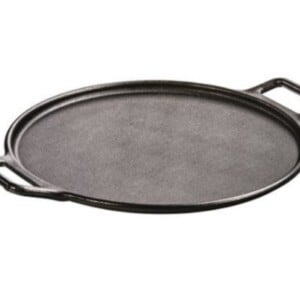
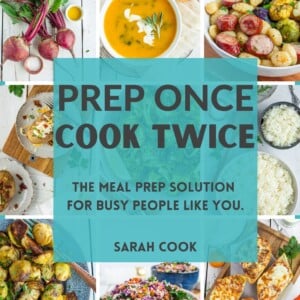






Ok… so I had a go at this today. Not a charity shop find but rather two bloody great big camp style Dutch ovens . Now.. these were neglected..I’ve had them from new but was derelict in my ‘seasoning’ duty when they were new. So… after about 6 years of ( Mis) use on Scout camps, I got them out for a proper clean and season.
I didn’t follow your instructions exactly..for a few reasons, the main one being these bad boys are humongous and o can only fit one in my oven at a time..and my oven eats electricity and that stuff ant cheap.. AND the pots have little feet on them, which is grand if you’re sitting on a campfire but bleeding useless on an electric induction hob.
But I cleaned( soap and water) , heated/steamed , scrubbed down with salt and oil, baked, oiled, baked , oiled…roughly ten mins in a very hot oven per ‘piece’.. pots and lids, and I’m really pleased with how they now look.
Going to be filling with beef and ale stew over the weekend, after I have made a few of your communion leaves to go along side.
I’m kind of confused. It says to put salt and oil in the pan then rinse then scrub the pan with the salt and oil. So do I scrub it and then rinse? Can you please clarify? I have three pans that need to be re-seasoned, which I’ve tried to do from a different persons instructions and they didn’t work. Please help!
Thanks for pointing that out. The blogging system I use will randomly copy bits of text from one part of the post and insert it into another part. I deleted the confusing/duplicate part and the instructions should be clearer now.
Thank you! Doing this today, I’m hoping it works better so I can use my pan tonight!
Let me know how it goes!
Hi Sarah,
So it is not so much the restoration that baffles me but rather, the “clean up” or lack thereof. What do you do after you’ve cooked your eggs? Just wipe the skillet off with a paper towel?
There are multiple options depending on what kind of mess you’ve made. 🙂 In most instances, a simple paper towel wipe is all you need. For some food that may have gotten stuck on the skillet, I’ll do a quick rinse and scrub in plain water (no soap!) while it is still warm. I put it back on the burner to dry, and then add a bit of butter to re-season it. We love cooking with cast iron, because we know there are fewer dishes to deal with!
My mom would buy very crustfied cast iron skillets at garage sales and put them in the oven and turn the oven to self-clean. They come out all cleaned up, but you have to re-season them. I have also cleaned my barbecue’s grates and lava rocks several times using this method.
I really really want to get comfortable using cast iron and get rid of my non-sticks. I see cast iron at thrift stores but figured if it was rusty that was the end of it. I am going to do this for sure! Wow that cleaned up beautifully! Thanks for the tutorial!
It sounds like cast iron skillets are the ultimate frugal cookware item… I’ll have to try this on the rusty one that’s in my basement!
I found my answer…..
“removing rust with a potato involves no magic. It involves oxalic acid, a natural rust remover. Potatoes can be used to remove rust from cast iron, baking pans, nuts and bolts, and other household items. If you really want to impress important people in your life, take a rusty knife and insert it in the potato. Let it set for a while. Remove it. Voila! No rust.”
Hi,
Is there some chemistry behind using salt to rid the rust??
I have two iron skillets I have been putting off restoring because I thought I was going to have to go at it with the steel wool and elbow grease forever.
The salt way looks too easy–I don’t get it? Chemistry?
-Heather
I followed your directions and now I have a sticky film in my pans. What did I do wrong? I didn’t have liquid oil, only Crisco. Was this bad to use?
I love cast iron too. A local iconic restaurant closed down last week and I was in there for a last meal. I saw a bunch of cast iron pans of all sizes hanging on the wall by wires. Since they were closing shop in an hour, I asked the owner if she would be interested in selling some of the pans. To my delight, she said yes. So I picked out 2 8″ pans and 2 10″ pans. Made sure they had the smooth interior and bought all 4 pans for $20. Yes! Score!!! They were very well used and a little cleaning up I have pans that I can hand down to my kids. Woot!